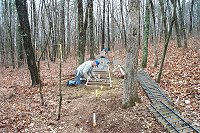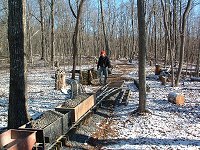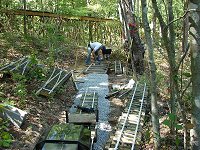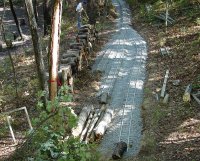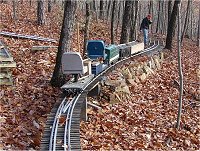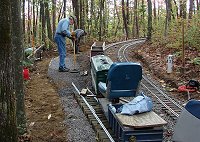|
Track Laying on the Eagle Point Railroad |
|
15,000 Feet and Counting |

Newly Expanded Eagle Point Yard |
|
 |
|
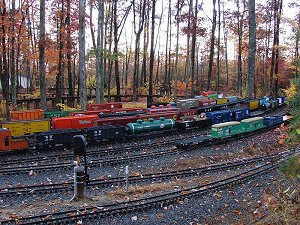
Yard in Full Use for Card-Order |
|
|
The Eagle Point Railroad is on 37 acres of some fairly rugged terrain
for a riding scale railroad, so some basic ideal standards are not possible.
The track has been built to standards from the beginning in 2000, however,
those standards had to be adjusted early on, as broad sweeping mainline curves
do not fit well in a mountain branchline setting. About 95% of the track is on
grade and curved.
There are three types of track; mainline with 2% grade and 60' radius,
mountain branchline with 2½% grade and 50' radius, plus over 60
industrial tracks, along with several yards.
All track is for 7½" gauge trains up to 2½" scale.
Standard clearance is 24" from centerline, however, there are some obstructions
at 18"; keep your knees and elbows in…
|
|
Basic Track Building Standards |

Track screw pattern holds gauge and keeps ties from folding; same as
prototypes. Note that the screw pattern forms an arrow, which is the
directions a loosened rail will slide. |
|
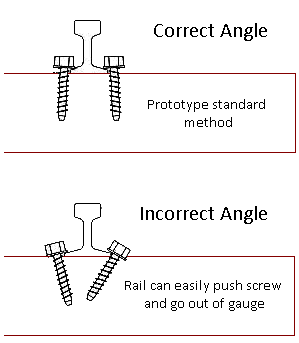
All screws have washers. |
|
The above screw pattern allows easy joining of new panels to existing
track without the need to cut rail when connecting the two panels, as
demonstrated below.
 |
|
|
EPRR Turnout Designs for #6, #7, #8, #10
This PowerPoint File contains all the information we use to build turnouts
for the railroad.
You may need to download a free PowerPoint reader. |
EPRR Turnout Designs
Free Download |
Free PowerPoint Viewer
Free Download |
|
|
Track and Roadbed |
| An ideal track would use a 48" base, a mountain railroad is lucky to get
36". Most of Eagle Point track is 36" ballast shown in dark gray and medium
gray profile. |
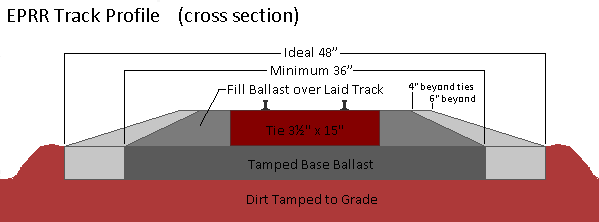 |
|
Track and Turnout
Construction Area |

Turnout and track jigs |

Custom wye turnout on jig |
|

Staining 15" ties |

Assembling 10' panels in jig |

#8 turnout in jig |
|
|
|
|
Custom Track Laying Fairly Routine |

Several custom fits to make it all work. |
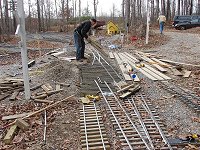
Installing tight-fit crossing |
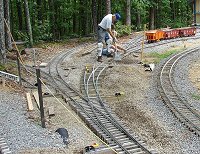
Wye turnout and curved turnout
starting at frog |
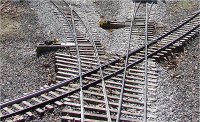
Pair of crossing on curved shop
lead built in place when new
yard added |
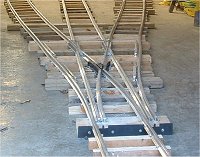
3-way turnout with removable
points to close overhead door |
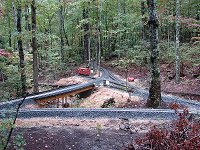
Wye in the valley |

Wye over the mountain gorge |

End of 88' tunnel |

Trestle work past rock out crop |

Adding track on an overhang |
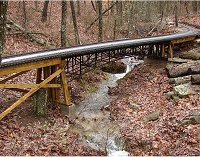
Arch over Stillhouse creek |
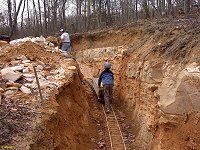
Any help on the cut was welcome |

Last days of cut after 18-months |
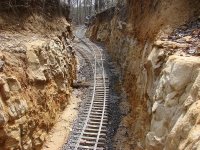
Turnout in cut |

Continue up or go back down |
|
| Routine scenes on railroad |
|

Annual weed control work |

Happens a couple times a year |

Red means approaching train
Must be snow plow... |
|
| Dealing with Extreme Rains |
|
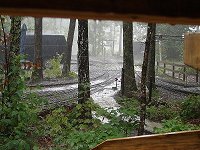
Wye track under water
extreme rain |

Area before drains were added |

Shows why concrete footers
were used |

Clogged drain pipe. |
|
| Why ash-pans should be checked |

As built |
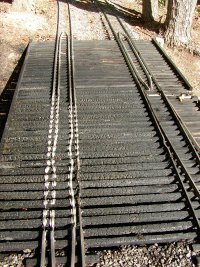 |
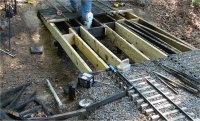
Repairs required after fire |

Rebuilt with fire pans |
|












